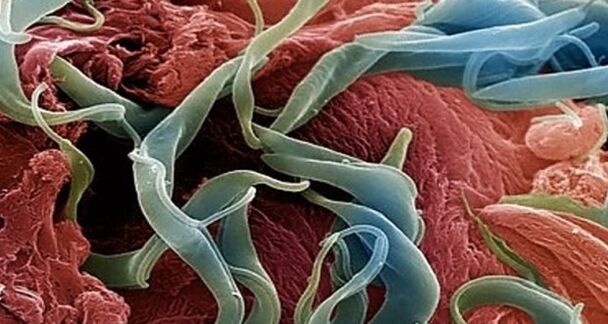
People and animals are attacked by these creatures, the infection is easily transmitted to each other through infected products, dirty water and hands.The appearance of parasites in the body will help prevent rules of prevention and careful observance of personal hygiene, but even these measures do not guarantee the protection of one hundred percent.Helminants who inhabit the human body can live in several organs, differ in appearance, size, as well as the degree of damage done to a person.
Parasites in the human body
How many situations are there when a person walks around doctors for years and cannot get rid of allergies, treat asthma, drink sugar drugs and everything in vain?Each of us has such acquaintances who spent large quantities in the treatment of several diseases and did not obtain any results.
Only in rare cases, when the doctor is very intelligent or very responsible, he directs that patient to a regular analysis of the feces and then ... then there are parasites in the human body, which causes dozens of diseases, and with which no one fights in the treatment of these pathologies.
Contrary to the established opinion, the worms are not "prescribed" in the intestines and can be detected by a banal analysis of the feces.Many parasites feel good in the lungs, heart, muscles, even in the brain and eyes.
The well -known malaria, which was once defeated, has returned again and this is the most dangerous parasitic disease in experts' opinion.Plasmodium of malaria lives exclusively in the blood and not all doctors can recognize this disease with enough confidence.
How parasites fall into the human body
They fall into the human body in different ways, more often this is due to the use of water and infected foods.
UVA eggs remain the viability for up to 6 months and through toys, carpets, underwear and pastel bedding they enter the body.Askarid eggs reach us inside through poorly washed vegetables and fruits.Barbecue or homemade butter is a 95% warranty of infection with tricinelosis.
The parasites penetrate into us with insect bites, when bathing in fresh water deposits, through the air, with dust, which is an egg bearer.
Salado fish, eschanine or caviar are the cause of tape worms infection, whose length reaches 12 meters and that can live in their body less than 25 years.Cases of infection of babies have become more frequent in parasites in the uterus.Dogs and cats, through their wet breathing, can dissipate parasite eggs at a distance of up to 5 meters.
It can be infected through dirty hands, not only yours, but also vendors, chefs, waiters, parasites travel for money and public transport handrails.A high concentration of parasite eggs in products is observed, such as: bacon, smoked sausage, ham, sausages, pork in any way, beef, chicken, lamb and even chicken eggs often infect with them.
The epidemiologists of the entire world are trying to fight this misfortune.In the United States, for example, for the verification of Helminthias, 1 pork car is destroyed in every thousand.This develops in multimillionaire losses, but otherwise it is impossible.
There are no absolutely reliable ways to disinfect meat, and ordinary culinary processing of the larvae does not destroy.It cannot guarantee the purity of your food welding or frying meat, a large number of parasites larvae still penetrates your body.
In which organs can live in parasites
Helmi parasites are divided into two categories that correspond to the place of activity in the donor's body:
- electric shock: worms living in several gastrointestinal sections.There are about 100 varieties of intestinal parasites, and for each intestine department there are a couple of dozen of species.The Delgado intestine is ready to take Ascaris, Antelost, wide tapes and other "brothers" less common.The thin intestine "will share the habitable space" with pointer worms, a dwarf chain and the rest.Medical literature describes cases where a person was infected with various types of parasites at the same time;
- Fabric:Worms located in organs, tissues and even in the blood.Modern medicine is successful with paragoniosis (lungs), quyticidosis (brain), equinococosis (liver) and rowairiosis (lymphatic vessels).Some worms of worms move through the body through the blood system and randomly bind to any organ.If many eggs have been introduced, then the whole body can become infected.
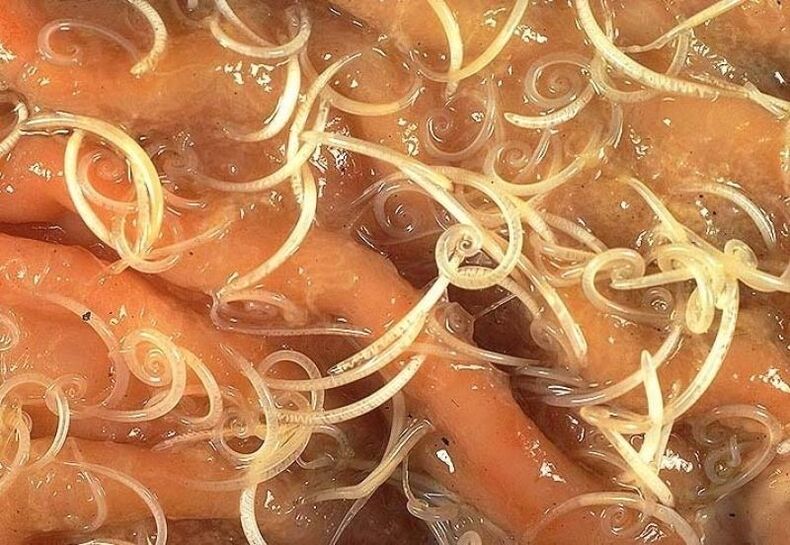
Snoes - How are they seen in the human body (photo of worms)
Speakers- These are one of the most common human parasites, which are a round worm (nematode).Most of the time, infection with worms is produced in children, but it is also found in adults.
The pin is a white, small and round parasite.Individuals of female individuals have dimensions: 8-13 mm long, 0.5 mm thick, oblong and straight tail, pointed at the end.
This female parasite feature explains its name: "cutter", of the word "acute".The male individual is much smaller: its length is 2-5 mm, the thickness is 0.2 mm, the tail is bent, unlike the female worms.
Human invasion has the name of enterobiosis and occurs mainly with the non -complement with personal hygiene rules (insufficient hand washing).Basically, PIN worms live in the small section of the intestine and the upper part of the large intestine, but in some cases they can also migrate to other organ organs and systems.

The female Helminto, having fallen into the human body with an oral form, and mating with the male representative of the nematode, migrates to the thick department of the intestine, where he receives the necessary nutrients for the life and maturation of the eggs of the waste of un digested foods.
After 4 weeks, the female cutter begins to migrate in the rectum at a speed of 12 cm per hour, crawls from the anus and puts around 5000-15000 eggs in the perianal region, which after 4-6 hours are completely matured and ready for an additional life cycle.
This process can be accompanied by itching, which encourages an infected person to comb the anus and, therefore, contribute to the propagation of parasites, which fall into food from under the nails, in the hands of other people (especially for children who are very in contact with each other and do not always observe personal hygiene rules).
The infection with pine nuts comes from a person to a person, through dust with parasite eggs, objects that the patient touched.Gutty's eggs can also be transferred to food with cockroaches and flies.
In addition, the eggs remain in linen, clothing, beds, which explains their rapid distribution.Due to the fact that the worm's life cycle is very fleeting, and the infection comes from a person to a person, it is quite difficult to get rid of the parasites, since in addition to taking antihelmíntic medications, the patient's personal belongings are necessary and their isolation of other nematodes media.
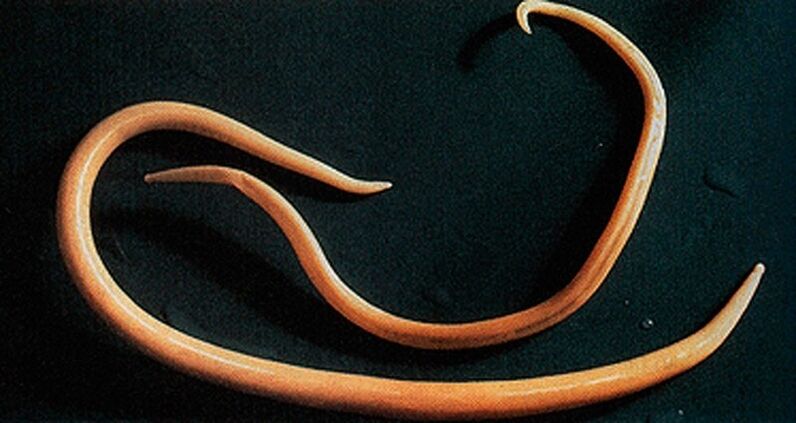
Askarides: How are they seen in the human body (photo of worms)
Askarida-This is a great parasite of a spindle-shaped form of a red yellow color, which reaches an adult state of 40 cm (females) and 15-25 cm (males).Without a cup of suction or other fixing devices, Ascaride can move independently towards food masses.The eggs established by the female parasite are distinguished with feces.
Acadosis infection occurs in case of swallowing ripe eggs along with water or vegetables and unwashed fruits in which there are soil particles.After the eggs penetrate the intestines, the mature larvae leave them.
Then, introducing into the intestinal wall, they reach the heart according to the blood flow, and from there they fall into the lungs.Through the pulmonary alveoli, the Ascarida larva through the respiratory tract penetrates the oral cavity again.
In the intestinal phase of its existence, the Ascaridos endowed with the ability of spiral movements can even penetrate the narrower holes.This characteristic of the parasite often leads to the development of quite serious complications (mechanical jaundice or pancreatitis)
After swallowing repeated, the parasite arrives at the small intestine, where it becomes an adult.The worm lives for 12 months, then dies and stands out with feces.In the intestines of an owner they can live both one or more hundreds of people.
Allergens secreted by ascárides can cause serious allergic reactions.A large number of adults can cause intestinal obstruction, and worms that have penetrated the respiratory tract sometimes cause suffocation.

Vlasovsov: How are they seen in the human body
BLACOVYVThey often live in the southern regions, since the eggs of this worm love heat.Most infections are observed in rural areas.Vlass's eggs live on the ground.
Invasia occurs through the hands, contaminated particles of the earth, poorly washed vegetables and fruits.As a result of infection, a disease occurs: trichocephah.Vlashev parasite in the intestines.This worm causes anemia, since it feeds on human blood and severe abdominal pain.
For the diagnosis of trichocephah, the rectum and the sigmoid intestine are examined with a special device (rectorcopy).Therefore, there are accumulations of parasites in the intestines.The treatment of the invasion is long, since the sores are protected by a thick roof.
Parasite eggs stand out with feces, but they are very small, they cannot always be seen under a microscope.Only with a very strong invasion it is possible to detect eggs in the analysis of the feces.They look like a barrel, they have a brownish yellow color.
On 2 sides, eggs are holes.How do worms look at stool?It is very difficult to find them alive in intestinal movements, since Blazoles cannot live for a long time outside the human body.Only with antihelmintic therapy can be seen in the feces of the dead worms of the white color.
Hepatic bacon: how is it seen in the human body
A parasite that causes opistorchiasis is a flat worm that reaches a length of 7-20 mm.
In the acute phase of Helmintiasis, the patient has pain at the top of the abdomen, body temperature increases, nausea, muscle pain develops, diarrhea and skin rashes are possible.The parasite larvae begin to develop after the eggs fall into fresh water (of the swallowed snails).Then they penetrate the fish of the fish (tent, cross tent, kiss, cockroach).
Human infection occurs when it eats infected fish that has not suffered enough heat treatment.The Larva of the hepatic pump of the small intestine penetrates the bile ducts to the gallbladder, fixing there with two cups of suction.
The chronic opistorchiasis course is manifested by symptoms of hepatitis, inflammation of bile ducts, cholecystitis, deteriorated digestive tract, nerve disorders, weakness and greater fatigue.The parasite is an impulse to the development of irreversible changes, and even after their expulsion, the patient does not pass chronic inflammatory processes and functional disorders.
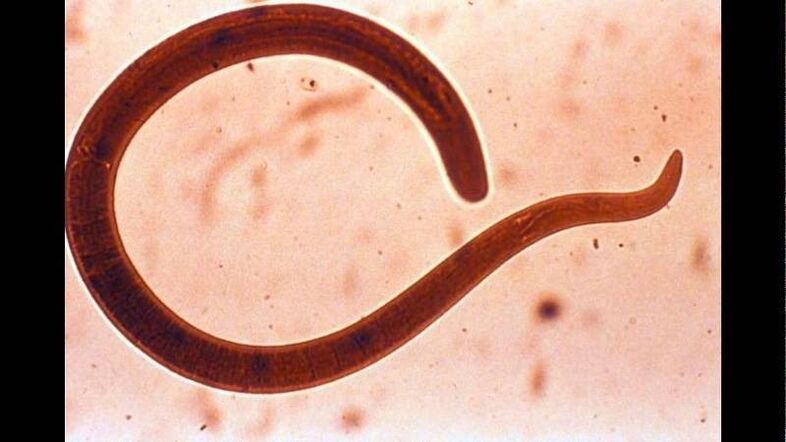
Trichinella: what looks in the human body (photo of worms)
The causal agent of trichinelosis is a small round helminto that reaches 2-5 mm in length.The infection occurs when the use of poorly fried meat (pork, bear puppies, wild boar).Penetrating the intestines, the parasite larva in 3-4 days mature in the state of the sexually mature individual.
The life expectancy of the worm is 40 days, after which the parasite dies.Condling the intestinal wall, the larvae penetrate the bloodstream and are transported in all organs of the human body, establishing in the muscles.In this case, respiratory and facial muscles, as well as the muscles-docked of the limbs, are often affected.
In the first days after the invasion, patients complain of abdominal pain.
Then, after approximately 2 weeks, the body temperature increases to 39-40 s, eruptions appear with hair hair, muscle pain develops and the face swells.
In this period, in the case of mass infection, there is a significant risk of death.After approximately a month, recovery occurs.The parasite is encapsulated spirally, after which it dies within two years.
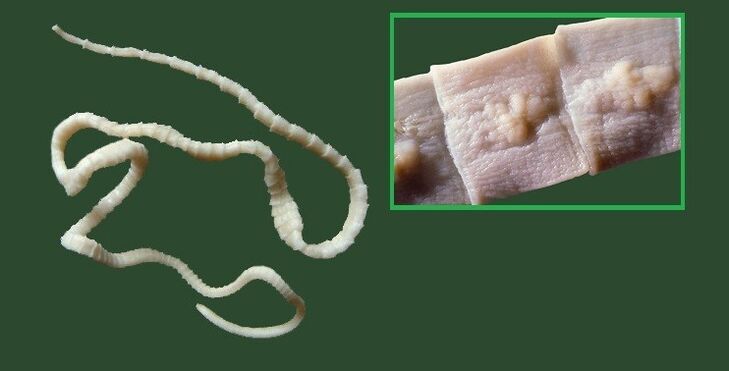
Wide tape: how is it seen in the human body
This is one of the largest helminths that reach a length of 10-20 meters.The disease caused by this parasite is called dipilobotriosis.The worm development cycle begins with freshwater fish or crustaceans.
Upon reaching the thin intestine, the parasite is linked to its wall and for 20-25 days a sexually mature individual grows.
The larva enters the human body, which is the final owner of a wide tape with caviar or infected fish fillet.
Diferobotriosis proceeds in the context of digestive tract disorders and deficiency anemia B12.
Echinococcus: How do you see a person's body
For this parasite, a person is an intermediate host.The parasite worm in the human body in the form of Finnish.The final owner of Echinococcus is a wolf, a dog or a cat.
The infection occurs in food in contact with animals and environmental objects, with the handful of Echinococcus eggs.After entering the intestines, the oncospheres (larvae of six black) develop from them.From the intestine they penetrate the bloodstream and are transported throughout the body.
The "favorite" parasitization places of the worm are the liver and light.Setting in these organs, the larva becomes a Finnish (equinoctic cyst), which, gradually increasing in size, begins to destroy nearby fabrics.
Often, equinococosis in the diagnostic process is confused with a tumor of benign or malignant origin.In addition to mechanical exposure (squeezing organs and blood vessels), sometimes a rupture of the equinoctic cyst occurs.This condition can cause toxic shock or the formation of multiple new cysts.
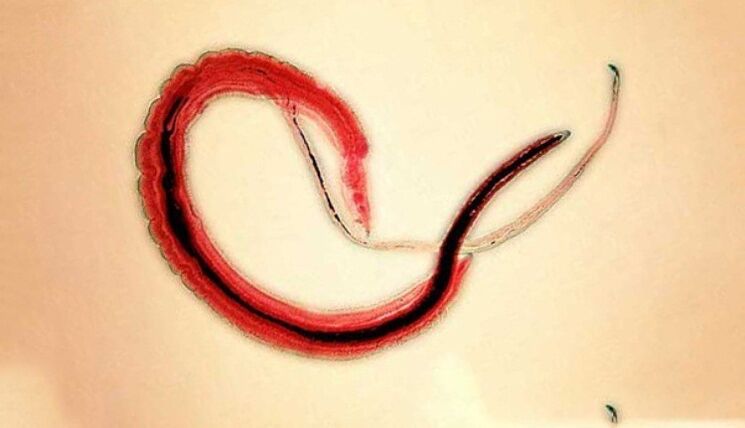
Alveococcus: How do you see in the human body
This parasite, which is considered a variety of Echinococcus, is the cause of one of the most dangerous Helmintiae (alveococosis), which is similar in gravity with cirrhosis and liver cancer.The infection occurs with the penetration of the oncosphere (eggs with mature larvae) in the intestines.
This parasite, considered a variety of equinoxes, is the cause of one of the most dangerous Helmintia (alveococosis)
There, the embryo leaves the egg and, introducing into the intestinal walls, penetrates the bloodstream.In addition, with a blood flow, the parasite spreads through all the tissues and organs of the body (more frequently located in the liver).It is there that the main stage of development begins in the larvae (a multiple cameras bubble, Laurelocyst)).
Each camera contains an embryo head of a parasite, which continues to be gradually developing.Lavcistas are very aggressive formations that grow constantly due to bubble increases, and also have the ability to germinate in the liver, such as cancer metastasis.
Nearby tissues due to the deteriorated operation of blood vessels are subject to necrotic changes.When opening nearby structures, Alveokkk forms fibrous nodes with the inclusions of multiple cameras bubbles.This condition can last several years, in relation to which it requires compulsory surgical intervention.
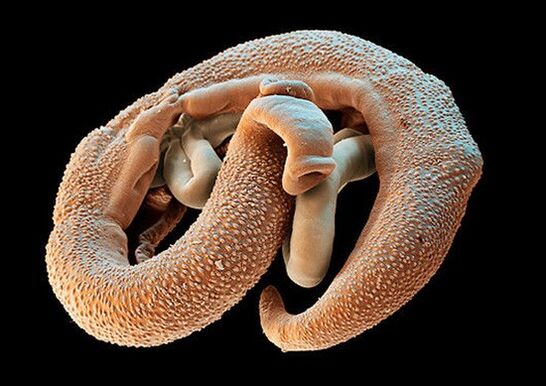
Schistosoma - How do you look in the human body?
Schistosoma, a blood saucer, belongs to the kind of trematodes, depending on the type causes several schistosomosis.This is a separate flat Helminth, reaches 4-20 millimeters in length, 0.25 mm wide.The body of the schistosome is equipped with the second cups of suction-ural and abdominal, they are close to the other.The females of the shales are longer and longer than the males.There is a longitudinal groove in the male body, with him, he holds the female.Its eggs with a diameter of 0.1 mm, oval shape, on the surface of one of the poles are a large spike.
Human worms of schistosomas in the role of the final owner choose people, in their organisms parasitize in small veins of the colon, abdominal cavity, uterus, bladder.The worms feed on the blood, partially absorb nutrients through the cuticle.Eggs with a shale are transported to intestines and bladder, where they mature and stand out with feces or urine.In the waters of water, a larva - Miucide, its intermediate host - mollusks leaves the eggs.In the body of the mollusk, the metacaría develops to the curials in 4-8 weeks.
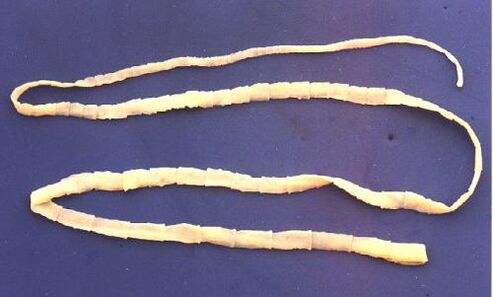
Pork tingle: How do you see in the human body?
The pig had, like the bull, in the body it has 4 cups of suction, but in addition to this, the body of the Helmint is also equipped with a double hook whistle.Strogil reaches two to three meters long.The pig had an ovary of three doping, on each side, the uterus has 7 to 12 branches.A characteristic feature of this Helminto is the ability of the segments to get out of the anus.After the exit to the outside, its peel dries and explodes, so the hemmintos eggs enter the external environment.The intermediate teacher of the Ten could be pigs and a person.
The main owner is a person.Intestinal parasites in humans include pork have, Helminto is found in the patient's intestines, where he puts his eggs.The infection occurs when invasive meat is used.
What doctor contact worms to contact?
If it is suspected that an infection with worms is suspected, then it is necessary Or a parasitologist.You can contact an infectious disease specialist regarding infection with any parasite or protozoa worm.
Or a parasitologist.You can contact an infectious disease specialist regarding infection with any parasite or protozoa worm.
You can contact a helminologist only if the infection is accurately suspected by parasitic worms (pins, ascárides, feathers, opistorchiasis, etc.).
You can contact a parasitologist in cases where the infection of protozoa is suspected: lamblia, toxoplasmas and amoebas.
In addition, if the parasite is located not in the light of the intestines or stomach, but in other organs (for example, lungs, liver), can contact a specialist who is dedicated to the diagnosis and treatment of diseases of this organ.That is, for example, with opistorchiasis, you can also contact a gastroenterologist or hepatologist, and with equinococosis to a pulmonologist.


















